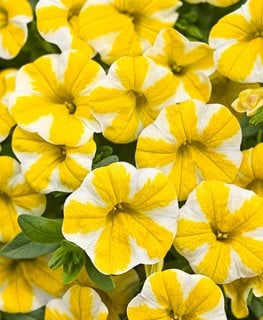HOW TO GROW CALIBRACHOA (SUPERBELLS® AND MILLION BELLS®)
Enjoy nonstop flowers in a rainbow of colors with Calibrachoa plants Reviewed by Denise Kelly, HorticulturistUpdated 02/09/22

Calibrachoa make excellent container plants. Pictured: Superbells® Pomegrante Punch™. Photo by: Proven Winners.
USDA hardiness zones:
9-11, annual elsewhere
Habit:
Sprawling
Height:
6 to 12 inches tall
Width:
12 to 24 inches wide
Exposure:
Full sun to part shade
Bloom time:
Planting until frost
Colors:
Coral, yellow, orange, red, pink, purple, blue and white
Common names:
Superbells®, Million Bells®, mini-petunias or trailing petunias
Calibrachoa is a popular garden annual that blooms continuously from planting until frost and is ideal for containers, hanging baskets, or raised beds. These petunia look-alikes offer a wide range of flower colors and patterns that look great by themselves, or when combined with other plants.
On this page: Planting | Care | Pictures | Landscaping Tips | Companion Plants
On this page:
CALIBRACHOA CARE
Calibrachoa will bloom all summer as long as their needs are met. Keeping them happy is relatively simple: The critical elements are sun, fertilizer, soil and water. They perform best in containers with excellent drainage.
Does Calibrachoa like sun or shade?
Calibrachoa plants bloom best with at least six hours of full sun, though they can tolerate partial shade. Without enough light flower numbers will decrease, the plants will stretch and the foliage turns light green.
How do you keep a Calibrachoa blooming?
Calibrachoa plants are heavy feeders. Nutrients are quickly leached from the soil by frequent watering, so fertilize regularly for continuous bloom. Use a water-soluble fertilizer every two weeks or add a slow-release granular fertilizer to the soil at planting time, replenishing according to instructions.
Soil:
For containers and hanging baskets, use a quality all-purpose potting mix that drains well. For bedding displays, soil should be well amended and drain quickly.
How often should I water my Calibrachoa?
Water calibrachoa when the top couple of inches of soil feel dry. During hot, dry weather, they can dry out quickly and may need daily watering. Stick your finger two inches into the soil; if it feels dry, then it’s time to water. Saturate the whole container so liquid drains from the bottom. Allow to dry slightly between waterings.
Should I deadhead Calibrachoa?
Calibrachoa are self-cleaning and require no deadheading. Pinch back tips occasionally to encourage branching, which will produce more flowers. To rejuvenate plants mid-season, cut branches to half their length and fertilize to stimulate new growth.
Diseases and pests:
Overwatering can lead to root rot or an infection from one of the Phytophthora species, which can kill plants. If plants are wilted after watering, this can be a sign of root rot. Heat stress can make plants susceptible to spider mites, and aphids.
Deer resistance:
Calibrachoa do not seem particularly tasty to deer; however, they are not classified as deer resistant.
PLANTING INSTRUCTIONS
When to plant:
Plant outside in mid-to-late spring after all danger of frost is past.
Where to plant:
Grow by themselves or in combination with other plants in containers or hanging baskets with well-draining soil. They can also be planted in beds or borders providing the soil is well amended and drains well; however, they perform best in pots.
How to plant:
Place potting mix in a hanging basket or container. Remove from the pot and gently tease the roots out if pot-bound. Place 6 to 12 inches apart and firm soil around the base. Water well to thoroughly wet the plant and settle the soil around it.
CALIBRACHOA VARIETIES
LANDSCAPING TIPS
One of the most versatile annuals, calibrachoa can be incorporated into any landscape. Here’s how:
- Place one or two tall ceramic pots near your home’s entrance and fill with colorful Superbells® to greet visitors.
- Adorn arbors and pergolas with hanging baskets brimming with your favorite colors.
- Plant window boxes that receive at least 6 hours of sunlight with colors that complement your home’s exterior.
- Shepherd’s hooks are a great way to add hanging baskets for instant color by a patio, deck or poolside. Hooks are easily moved around for a fresh look.
- Place a hanging basket outside your kitchen window to enjoy a burst of color whenever you’re cooking or doing dishes. This will attract hummingbirds and butterflies up close where you can most appreciate them.
COMPANION PLANTS
Calibrachoa combine well with many other annuals. Get creative and make your own custom containers using the principle of “thriller, filler, and spiller.”
- Combine them with taller plants such as angelonia, coleus, African daisy, purple fountain grass, zonal geranium, or Persian shield.
- Add fillers such as coral bells, lantana, marigold, or sedges.
- Companion trailers include sweet potato vine, fan flower (Scaevola), verbena, bidens, bacopa, or nemesia.
RELATED:
How to Create a Container Planting
Colorful Plant Combinations for Containers
The 24 Best Plants to Attract Hummingbirds
24 Purple Flowers to Brighten Your Garden
Amazing Annuals for Sun










